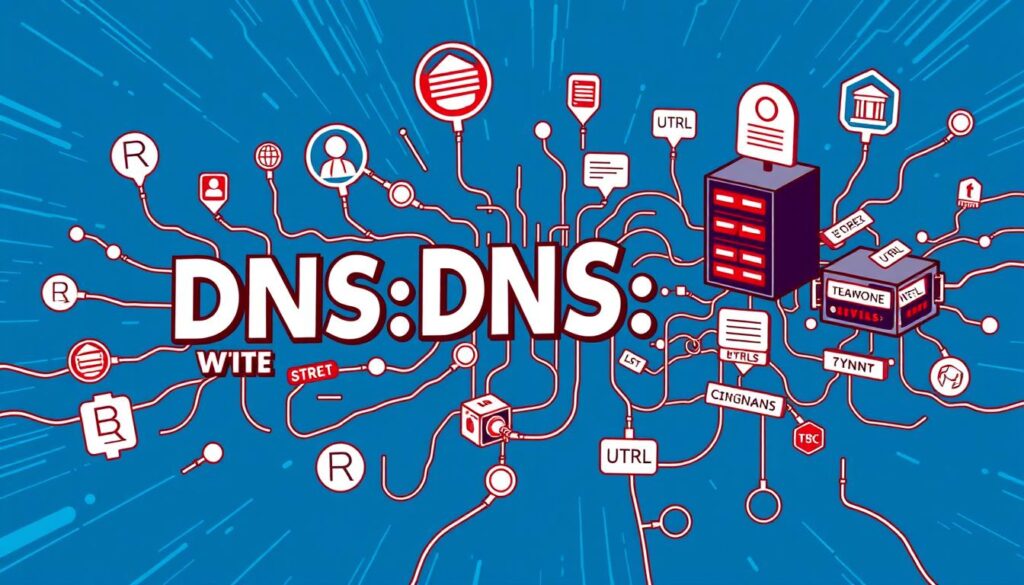The Domain Name System (DNS) is key to the internet. It connects easy-to-use domain names to the numbers computers use to talk to each other. Knowing how DNS works helps us see its big role in making the web easy to use. This article will dive into DNS’s role in networking and its parts that make it work well.
Key Takeaways
- DNS translates human-readable domain names into IP addresses needed by computers.
- The Domain Name System is essential for seamless internet navigation.
- Understanding how DNS works helps enhance web development and networking skills.
- Key components of DNS include servers and various types of DNS records.
- DNS resolution is the process that allows browsers to retrieve content from the web.
Understanding the Domain Name System (DNS)
The Domain Name System is key to navigating the internet. It’s like a big database that changes domain names into IP addresses. When you enter a website’s name in your browser, it sends out a DNS query.
This query finds the IP address for the site. This lets you quickly visit the website you want.
Knowing about DNS is important. It works like an online phonebook. It lets users find websites without remembering long numbers.
This makes getting information online easier. The Domain Name System helps make browsing smooth. It lets everyone easily find their favorite websites.
What is DNS and Its Importance in Networking?
The Domain Name System (DNS) is key to modern networking. Without it, we’d have to remember long IP addresses. This makes the internet hard to use. The DNS importance is in making domain names easy to use, turning them into IP addresses for computers.
In DNS in networking, we find services like load balancing and failover. These help networks work better, reducing downtime. This means users can always find what they need online. Businesses use DNS to make their websites better, making users happier.
Also, DNS helps track website traffic and understand user habits. By using DNS capabilities, network managers can improve security and manage networks better. DNS is the internet’s backbone, making it easy and efficient for everyone.
How DNS Works: The Process of DNS Resolution
Understanding how DNS works is key for internet users. This system turns domain names into IP addresses. It does this through a detailed process called DNS resolution.
When you type a domain name into your browser, a process starts. It sends domain name queries to different DNS servers. First, it goes to a recursive resolver, which helps connect your device to higher DNS servers.
The recursive resolver then sends the query to root DNS servers. These servers guide the resolver to the right authoritative DNS servers. These servers have the domain’s IP address. Once found, the IP is sent back to your browser quickly.
DNS caching helps speed things up. Caches are on browsers, operating systems, ISPs, and recursive servers. They save time by not having to ask for the IP address every time.
If DNS resolution problems occur, clearing your DNS cache can help. It removes old or bad data. This prevents DNS spoofing and ensures you reach the correct site. You can flush your DNS cache using specific commands, depending on your system or browser.
Learning more about how DNS works can improve your online experience. Knowing about DNS resolution and its importance makes browsing faster and safer.
Key Components of DNS: DNS Servers and DNS Records
Understanding DNS is key to knowing how it works. It uses DNS servers and records. There are three main types of DNS servers: recursive resolvers, root name servers, and authoritative name servers. Each type has a special role in making sure websites are easy to find.
DNS servers help by finding the IP address for a domain name. Recursive resolvers start the search, passing the query until it finds the right server. Root name servers help by giving info on top-level domains, which are at the top of the DNS tree.
DNS records are also very important. They store data about domain names and their IP addresses. There are different types of records, like A records, AAAA records, CNAME records, and MX records. Each one helps direct traffic on the internet.
Knowing about DNS helps fix internet problems and make websites run better. It’s all about understanding how DNS works.
| Component | Function | Type |
|---|---|---|
| Recursive Resolver | Handles client requests and resolves them to the correct IP address | DNS Server |
| Root Name Server | Directs queries to TLD (Top-Level Domain) servers | DNS Server |
| Authoritative Name Server | Provides answers to queries with exact records | DNS Server |
| A Record | Links domain names to IPv4 addresses | DNS Record |
| MX Record | Specifies mail exchange servers | DNS Record |
| CNAME Record | Aliases one domain to another | DNS Record |

Knowing about DNS servers and records helps you manage your domain better. It makes your website work better too.
Types of DNS Records You Should Know
Knowing about different DNS record types is key for your website’s smooth operation. Each record type is important for linking domain names to their resources. This affects how well your DNS performs. Here, we’ll look at some common DNS records that every website owner or admin should know.
A Overview of Common DNS Record Types
Many DNS record types work together to make the internet work smoothly. Let’s take a quick look at some of the most common ones:
| Record Type | Description | Example |
|---|---|---|
| A Record | Links a domain name to its IPv4 address. | example.com → 192.0.2.1 |
| CNAME Record | Makes one domain name an alias for another. This lets multiple domains point to the same IP address. | www.example.com → example.com |
| MX Record | Tells where to find email servers for a domain. | example.com → mail.example.com |
How DNS Records Impact Your Website’s Performance
Managing DNS records well is crucial for your site’s performance. Old or wrong records can cause problems like slow loading or downtime. Keeping your records up to date ensures fast connections for your domain’s visitors.
To make your website more reliable, check and update your DNS records often. Use tools to track how well your site is doing. Also, think about using quantum encryption to protect data as you work on improving DNS performance.
Exploring DNS Caching and Its Benefits
DNS caching is key to making the Domain Name System (DNS) faster and more efficient. It stores recent DNS queries and their IP addresses. This way, when you try to visit a website, it can quickly find the info in the cache.
This makes web pages load faster, giving you a better browsing experience. DNS caching is not just about speed. It also helps your network by reducing the load on DNS servers.
This can make servers more stable and help manage bandwidth better. By using DNS caching, website managers can improve performance. This ensures users have a smooth browsing experience.
Knowing how DNS caching works can help in managing your website better. It’s useful for both companies and individuals looking to improve their online presence. Efficient DNS caching saves time and makes the internet more reliable.

The Role of IP Address Resolution in DNS
IP address resolution is key to the Domain Name System (DNS). It turns domain names into IP addresses, making internet communication smooth. When you type a website’s URL, DNS converts it into an IP address. This lets your device find and connect to the server.
How well IP address resolution works affects network speed. Slow or wrong resolutions can make websites load slowly. This makes online access less reliable. Fast resolution means quicker access to websites, which is important today.
It’s important to understand how IP address resolution works with DNS. The diagram below shows how domain names, IP addresses, and DNS are connected:
| Component | Description |
|---|---|
| Domain Name | The human-readable address you enter in a browser (e.g., www.example.com). |
| IP Address | The machine-readable address used for identifying devices on a network (e.g., 192.0.2.1). |
| DNS Server | A server that translates domain names into IP addresses. |
| Resolution Process | The series of steps taken by DNS to convert a domain name into an IP address. |
Boosting IP address resolution efficiency improves network performance. Using best practices like optimizing DNS servers and caching can speed up resolutions. This benefits everyone and makes the internet work better.
DNS Protocols: Understanding the Underlying Technologies
To truly understand DNS, you must learn about the DNS protocols that form its base. The main protocols used in DNS are User Datagram Protocol (UDP) and Transmission Control Protocol (TCP).
UDP is preferred for DNS queries because it’s fast. This speed ensures quick results when you need to find a domain name. On the other hand, TCP is essential for reliable tasks, like transferring data between servers.
Knowing about these DNS protocols helps you see how DNS handles different requests. It’s important to understand how these technologies impact performance, scalability, and reliability. By knowing when to use UDP or TCP, you can improve how your network operates.
Conclusion
Understanding the Domain Name System (DNS) is key for anyone online. It makes surfing the web easier and keeps your data safe. DNS is essential for smooth and secure website access.
Knowing how DNS works helps improve your website’s speed. With services like Gmail used by over 2.5 billion people, DNS knowledge is vital. It also helps protect against cyber threats, like the one a Microsoft consultant faced.
Learning about DNS boosts your online presence and security. It’s a smart investment for better networking and digital safety. So, take the time to understand DNS for a stronger online presence.
FAQ
What is the Domain Name System (DNS)?
The Domain Name System (DNS) is a system that makes it easier to use the internet. It changes domain names into IP addresses. This way, you don’t have to remember long numbers to visit websites.
How does DNS resolution work?
DNS resolution is a process that starts with a query from your device. It goes to different DNS servers to find the IP address for a domain name. This process involves recursive resolvers and authoritative servers.
Why is DNS important in networking?
DNS is key in networking because it makes the internet easier to use. It helps with services like load balancing and failover. This improves network reliability and performance.
What are some common types of DNS records?
There are several types of DNS records. A records link domain names to IP addresses. CNAME records connect one domain to another. MX records tell where to send email.
What is DNS caching, and how does it benefit users?
DNS caching stores DNS query results temporarily. This makes it faster to load websites. It also reduces the load on DNS servers.
What role does IP address resolution play in DNS?
IP address resolution is vital in DNS. It changes domain names into IP addresses. This is necessary for devices to communicate on the internet.
What protocols does DNS operate on?
DNS uses UDP for fast communication and TCP for reliable transfers. This is especially true during zone transfers.
How do DNS servers function?
DNS servers have three main roles. Recursive resolvers handle client queries. Root servers guide queries to TLD servers. Authoritative servers provide the final answers for domain queries.
How can I optimize my website’s DNS performance?
To improve your website’s DNS performance, keep your DNS records up-to-date. Use DNS caching well. Choose reliable DNS servers to speed up resolution times.
Source Links
- 1. Azure AD Connect: Hybrid Identity Management
- 2. Signals
- 3. A Step-by-Step Guide to Scalable Web Application Architecture
- I Learned About AI Mistakes That Could Change Your Life
- Sustainable & Green Energy Solutions for Next‑Gen Data Centers Trend Report
- Learn How to Start a Career in a Data Centre: Skills, Certifications & First Steps
- My Guide to Understanding Data Centre Architecture: Core Components Every IT Pro Should Know
- Wazuh Home Network Setup: A Step-by-Step Guide
Related posts:
 How AI is Revolutionizing the E-commerce Industry
How AI is Revolutionizing the E-commerce Industry
 The Role of Quantum Computing in Drug Discovery
The Role of Quantum Computing in Drug Discovery
 How to Ensure Data Privacy Compliance in 2024
How to Ensure Data Privacy Compliance in 2024
 How to Use Digital Twins for Predictive Maintenance in 2024
How to Use Digital Twins for Predictive Maintenance in 2024
 How to Automate Recruitment and Employee Management with AI
How to Automate Recruitment and Employee Management with AI
 How to Implement IoT for Remote Patient Monitoring
How to Implement IoT for Remote Patient Monitoring
